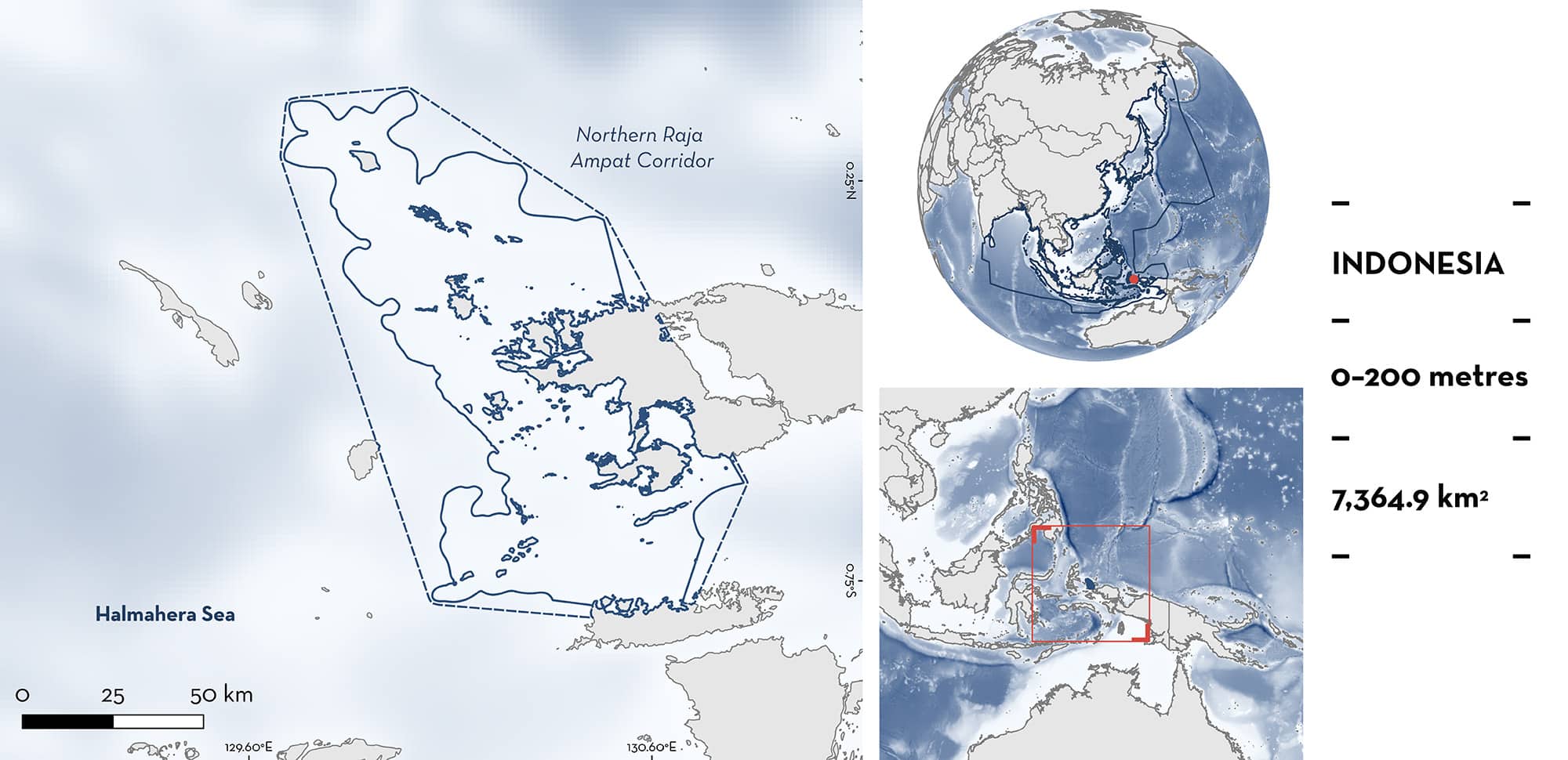ISRA FACTSHEETS
ISRA FACTSHEETS
ASIA REGION
Northern Raja Ampat Corridor
Summary
Northern Raja Ampat Corridor is located in Southwest Papua, Indonesia. The area includes several islands and bays and has an extended shelf characterised by the presence of coral reefs. It overlaps with one Ecologically or Biologically Significant Marine Area, one Key Biodiversity Area, and four marine protected areas. Within the area there are: threatened species and movement areas (Reef Manta Ray Mobula alfredi).
Download factsheet
Northern Raja Ampat Corridor
DESCRIPTION OF HABITAT
Northern Raja Ampat Corridor is located in Southwest Papua, Indonesia. The area includes several islands, bays, and the Dampier Strait that separates Waigeo, the largest island in the area, from Batanta Island. The area has an extended shelf characterised by the presence of coral reefs. It is situated within the Bird’s Head Seascape, recognised as a global hotspot of coral reef biodiversity and for marine megafauna (Allen & Erdmann 2009).
The area overlaps with the Raja Ampat and Northern Bird’s Head Ecologically or Biologically Significant Marine Area (EBSA; CBD 2024) and the Waigeo Barat Key Biodiversity Area (KBA 2024). It also overlaps with four marine protected areas: KKPN Kepulauan Waigeo Sebelah Barat Marine Nature Reserve, KKPN Kepulauan Raja Ampat Marine Nature Reserve, Selat Dampier (Raja Ampat), and Pulau Sayang Wildlife Sanctuary.
This Important Shark and Ray Area is pelagic and is delineated from inshore and surface waters (0 m) to 200 m based on the bathymetry of the area.
CRITERION A
VULNERABILITY
One Qualifying Species considered threatened with extinction according to the IUCN Red List of Threatened Species regularly occurs in the area. This is the Vulnerable Reef Manta Ray (Marshall et al. 2022).
CRITERION C
SUB-CRITERION C4 – MOVEMENT AREAS
Northern Raja Ampat Corridor is important for the movement of one ray species.
Regular movements of Reef Manta Rays have been confirmed using satellite and acoustic telemetry and photo-identification. Movements in the area connect aggregation sites, feeding areas, and reproductive areas of Reef Manta Rays in Dampier Strait (e.g., Dayan, Wai, Manta Ridge, and Arborek) and northwest Waigeo (e.g., Yefnabi Kecil, Eagle Rock, and Wayag; Setyawan et al. 2018, 2022a, 2022b; Setyawan 2023). Aggregation sites are located within a 150 km corridor from Wayag lagoon in northwest Waigeo to Dampier Strait (Setyawan et al. 2018, 2022a, 2022b; Setyawan 2023).
Of 167 individuals acoustically tagged in the southern part of the area between 2013–2019, regular back and forth movements were recorded to northern sites (Setyawan et al. 2018). Reef Manta Rays tagged were detected mostly near tagging sites, but seasonal movements were recorded, with a larger number of detections from December to April at sites around Dampier Strait and from June to October in northern sites west of Waigeo Island (Setyawan et al. 2018). Of 78 individuals tagged between 2016–2020, 72 were detected in the four subregions: Dampier Strait, West Waigeo, Fam and Bambu, and Wayag Island (Setyawan et al. 2018; Setyawan 2023). Movements between aggregation sites in the area were also confirmed from data originating from six individuals tagged with satellite transmitters between 2014–2021 in Dampier Strait and Northwest Waigeo (Setyawan 2023). In addition, 108 Reef Manta Rays were recorded moving between aggregation sites in Dampier Strait and Northwest Waigeo based on photo-identification between 2013–2019 (Setyawan et al. 2020).
These movement patterns are likely influenced by changes in biomass and distribution of phytoplankton produced by seasonal monsoons. During the southeast monsoon, upwelling and primary productivity increase near western Waigeo attracting Reef Manta Rays to sites around it while during warmer northwest monsoon, individuals rely more on zooplankton available near Dampier Strait where currents passing through the strait carry zooplankton to feeding sites there.
Download factsheet
SUBMIT A REQUEST
ISRA SPATIAL LAYER REQUEST
To make a request to download the ISRA Layer in either a GIS compatible Shapefile (.shp) or Google Earth compatible Keyhole Markup Language Zipped file (.kmz) please complete the following form. We will review your request and send the download details to you. We will endeavor to send you the requested files as soon as we can. However, please note that this is not an automated process, and before requests are responded to, they undergo internal review and authorization. As such, requests normally take 5–10 working days to process.
Should you have questions about the data or process, please do not hesitate to contact us.


